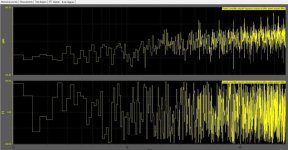I would expect the Bode plot to look something like this:
http://www.plctalk.net/qanda/attachment.php?attachmentid=33699&stc=1&d=1410286934
Page 1 shows the data I used. Each row is the time in milliseconds, target position, actual position, target velocity, actual velocity, control output and status bits. I am using 1 seconds' worth of data or 1000 readings. Not just a few like most auto tuners.
There are a bunch of calculations between the first page and the second page that I am reluctant to show.
Page 2-3 shows that the model I calculated is pretty good. My estimated position, velocity match the actual data closely. Notice that the velocity calculated from the feed back shows the effects of quantizing due to the feedback resolution and that my estimated velocity is much smoother but isn't filtered or delayed like most controllers would do. I display the actual acceleration. Notice that it too is smooth. There is no way the acceleration can be calculated directly from the feed back device. The green line is the control output used to excite the actuator. Most system identifications use square waves because it is easier but try a square wave when trying to tune a hydraulic actuator with a 90 ton roll of steel on it and you will be asked to leave quickly.
page 4. I would expect the Bode plot to look something like this.
Since I am plotting the response for position the Bode plot starts out with a 90 degrees phase lag. This happens because the velocity is integrated to get position. This adds 90 degrees of phase shift. A velocity Bode plot should start at 0 degrees of phase shift and then drop as the frequency gets higher. Notice this is a resonance peak at about 20Hz and the phase lag increases rapidly. This is what a resonance peak looks like and I see nothing like it in Plc_User's data.
In Plc_User's graphs there is no way the data can change that much from one frequency to another.






